Understanding the Strategic Value of Combined Transportation Methods
In today's complex global supply chain landscape, businesses face increasing pressure to optimize their shipping operations while maintaining cost-effectiveness and reliability. Multimodal transport has emerged as a sophisticated solution that combines different modes of transportation to create seamless end-to-end delivery systems. This integrated approach to logistics not only offers enhanced flexibility but also provides businesses with strategic advantages in an increasingly competitive marketplace.
As supply chains become more intricate and customer expectations continue to rise, the traditional single-mode transportation methods may no longer suffice. Multimodal transport enables companies to leverage the strengths of various transportation modes while minimizing their individual limitations. This comprehensive approach to shipping has become particularly relevant as businesses seek more resilient and adaptable logistics solutions.
Key Benefits of Implementing Multimodal Transportation
Cost Optimization and Economic Advantages
One of the primary reasons businesses turn to multimodal transport is the potential for significant cost savings. By combining different transportation modes, companies can optimize their shipping expenses based on factors such as distance, cargo volume, and time sensitivity. For instance, using rail transport for long-distance inland movement combined with short-haul road delivery often proves more economical than relying solely on road transport.
The economic benefits extend beyond direct transportation costs. Multimodal transport can lead to reduced warehouse expenses, lower insurance premiums, and decreased handling costs. Companies can also benefit from economies of scale by consolidating shipments and optimizing cargo space across different modes of transport.
Environmental Sustainability and Carbon Footprint Reduction
Modern businesses increasingly prioritize environmental responsibility, and multimodal transport offers substantial sustainability benefits. By strategically combining transportation modes, companies can significantly reduce their carbon emissions compared to single-mode alternatives. Rail and water transportation, in particular, typically generate lower emissions per ton-mile compared to road transport.
The environmental advantages of multimodal transport align well with corporate sustainability goals and regulatory requirements. This approach enables businesses to demonstrate their commitment to green logistics while maintaining operational efficiency and service quality.
Operational Considerations for Multimodal Transport Implementation
Infrastructure and Network Requirements
Successful implementation of multimodal transport requires careful assessment of available infrastructure and network capabilities. Businesses must evaluate the accessibility and reliability of different transportation modes in their operating regions. This includes analyzing the availability of intermodal terminals, port facilities, rail connections, and road networks that will support seamless cargo transfers.
The quality and compatibility of infrastructure across different modes significantly impact the efficiency of multimodal operations. Companies should consider investing in or partnering with providers who maintain modern handling equipment and technology-enabled tracking systems to ensure smooth transitions between transportation modes.
Risk Management and Security Considerations
While multimodal transport offers numerous advantages, it also introduces complexity in terms of risk management. Businesses must develop comprehensive strategies to address potential challenges such as cargo handling during mode transitions, documentation requirements, and liability issues. This includes implementing robust tracking systems, securing appropriate insurance coverage, and establishing clear protocols for handling unexpected disruptions.
Security measures become particularly important when shipments change hands between different transport providers. Companies should invest in technologies and procedures that ensure continuous monitoring and maintain the integrity of their cargo throughout the entire journey.
Strategic Timing for Multimodal Transport Adoption
Market Expansion and Geographic Considerations
Businesses should strongly consider implementing multimodal transport when expanding into new markets or serving geographically diverse customers. This approach becomes particularly valuable when dealing with cross-border trade or accessing remote locations that may be challenging to serve through single-mode transportation.
The decision to adopt multimodal transport often aligns with strategic growth initiatives, especially when entering markets with varying infrastructure capabilities or regulatory requirements. Companies can leverage the flexibility of multiple transport modes to optimize their market reach while maintaining service reliability.
Volume and Frequency Analysis
Shipping volume and frequency play crucial roles in determining the viability of multimodal transport solutions. Businesses experiencing steady growth in shipping volumes or dealing with regular large-scale shipments often find multimodal options more cost-effective and efficient. The ability to consolidate cargo and optimize capacity across different modes becomes increasingly valuable as shipping volumes grow.
Regular assessment of shipping patterns and volume trends helps companies identify the optimal timing for transitioning to multimodal transport. This analysis should consider seasonal variations, growth projections, and changing customer requirements to ensure the chosen solution remains sustainable long-term.
Frequently Asked Questions
What are the primary cost factors in multimodal transport?
The main cost components include mode-specific transportation charges, handling fees at transfer points, documentation expenses, insurance costs, and potential storage fees during transit. Companies should also consider investment in technology and systems needed to manage multimodal operations effectively.
How does multimodal transport impact delivery times?
While multimodal transport may sometimes involve longer transit times due to mode transfers, it often provides more reliable overall delivery schedules. The ability to bypass congestion points and utilize faster modes for certain segments can actually improve delivery consistency and predictability.
What technology support is needed for multimodal transport?
Successful multimodal transport typically requires integrated tracking systems, transportation management software, real-time visibility tools, and communication platforms that facilitate coordination between different service providers and stakeholders in the supply chain.




